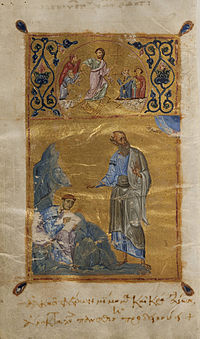Our website is made possible by displaying online advertisements to our visitors.
Please consider supporting us by disabling your ad blocker.
Codex Basilensis A. N. IV. 2
| New Testament manuscript | |
 Folio 265 verso, portrait of John and Prochor | |
| Name | Basiliensis A.N.IV.2 |
|---|---|
| Text | New Testament (except Apocalypse) |
| Date | 12th century |
| Script | Greek |
| Now at | Basel University Library |
| Cite | K. Lake, Codex 1 of the Gospels and its Allies, (Cambridge 1902) |
| Size | 18.5 cm by 11.5 cm |
| Type | Caesarean, Byzantine text-type |
| Category | III, V |
| Hand | elegantly written |
| Note | member of f1 |
Codex Basilensis A. N. IV. 2 is a Greek minuscule manuscript of the entire New Testament, apart from the Book of Revelation. Using the study of comparative writings styles (palaeography), it is usually dated to the 12th century CE. It is known as Minuscule 1 (in the Gregory-Aland numbering of New Testament manuscripts), δ 254 (in von Soden's numbering of New Testament manuscripts),[1] and formerly designated by 1eap to distinguish it from minuscule 1rK (which previously used number 1).
The manuscript was prepared for liturgical use with marginalia (text division), and has almost completely survived; Erasmus used it for his Novum Instrumentum omne (an edition of the Greek New Testament). The text of the manuscript has been cited in all critical editions of the Greek New Testament; in this codex, the text of the Gospels is more highly esteemed by scholars than that of the remaining New Testament books. The codex is housed at the Basel University Library, with shelf number A. N. IV, 2 (earlier B. VI. 27).[2]
- ^ Gregory, Caspar René (1908). Die griechischen Handschriften des Neuen Testament. Leipzig: J. C. Hinrichs. p. 48.
- ^ Anderson, Amy S. (2004). The Textual tradition of the Gospels: Family 1 in Matthew. Leiden; Boston: Brill. p. 108.
Previous Page Next Page


